Keywords
|
| OFDM, 60GHz, Pilot design, Channel estimation, Frequency selective fading. |
INTRODUCTION
|
| Over the last few years, networks have become a part of everyday work for nearly everybody. The 60 GHz band has recently been allocated worldwide for unlicensed wireless communication systems. The U.S, Europe and Japan have allocated at least 5 GHz of contiguous bandwidth, which is equal to all other communication combined. It attracts great interest from both academic and industry [1, 2, 3]. The bandwidth allows enormous data rates to be transmitted. Which effectively meet the transmission demand for HD Video without compression and wireless docks, etc. However, wireless signals of 60 GHz attenuates quickly in air and have high absorption rate for oxygen( ). Due to which the transmission range is confined to few meters. The primary goal is to allow faster networking speed in dense deployment and ultrafast speed in home. |
| At the present scenario for 60 GHz technology mainly includes 3 international standards, they are ECMA-387 standard [4], IEEE 802.15.3cstandard [5], and IEEE 802.11adstandard [6]. A modulation mode of the standard all includes OFDM and Single carrier modulation. |
| OFDM has recently been applied widely in wireless communication systems, due to its high data rate transmission capability with high bandwidth efficiency and its robustness to multipath delay. It has been used in wireless LAN standards, such as America’s IEEE 802.11ad and the European’sequivalent HIPERLAN/2 and in multimedia wireless services such as Japanese Multimedia Mobile Access Communication. In OFDM channel estimation, there are variety of algorithm with different performance level and different numerical complexity. OFDM Technology can utilize simple frequency domain equalization(FDE) method which is robust for the delay spread environment, adding to more advantages include the use of Fast Fourier/Inverse Fourier Transform(FFT/IFFT) algorithm. Thus for more advantages of OFDM, it has a widespread research and application . |
| A Dynamic estimation of channel is necessary before the demodulation of OFDM signals since the radio channel is frequency selective for wideband communication systems. In OFDM pilot-aided channel estimation is preferred for better performance and throughput, the channel estimation can be performed by either inserting pilot tones into all of the subcarrier of OFDM symbols with an specific period , calledBlindtype pilot channelestimation or can be done by inserting pilot tones into each OFDM symbol, called Combtype pilot arrangement. |
| For 60 GHz OFDM application there are a lot of new characteristics, the frame duration is short and the symbol rate is fast. Therefore, it is appropriate to model 60 GHz channel as slowly time-varying channel. In previous 60 GHz study, many 60 GHz system design assume that the channel is invariant in the whole frame duration.Channel estimation is done in preamble part and its result is used in payload. The channels of pilot subcarriers are directly estimated and that of non pilot subcarrier are estimated through interpolation. Simple interpolation method, such as linear interpolation exhibits a performance floor with 60 GHz systems over complex interpolation, as its numerical complexity is very high. |
| The rest of this paper is organized as follows: In section II we present the system description of the proposed channel estimation algorithm and channel model. Three kinds of existing algorithm and the proposed algorithm in section V. Simulation results are described in section VI and we conclude in section VII. |
SYSTEM DESCRIPTION
|
| A . Block Diagram. |
| Fig1. Shows the block diagram of .IEEE 802.11ad, introduced new terminology to identify the higher performance of PHY’s. They are termed as VHT(Very High Throughput) and DMG(Directional Multi-Gigabyte). VHT is used for any frequency band that has a starting frequency below 6 GHz excluding the 2.4 GHz, whereas DMG pertains to operate in frequency band that contains a channel with a channel starting frequency above 45 GHz. |
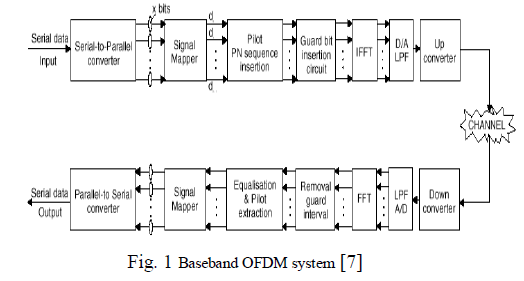 |
| The DMG PHY supports three modulation, They are Control Modulation (Control PHY), Single Carrier modulation (SC PHY), Low Power Single Carrier modulation(LPSC PHY), and the OFDM modulation(OFDM PHY). All of these modulation share common preamble. DMG PHY have 3 functional entities , The Physical Layer Convergence Protocol (PLCP) sublayer , The Layer Management Function (PLME) and The Physical Medium Dependent( PMD) sublayer. The PMD sublayer makes up standards for characteristics of wireless medium such as DSSS or FHSS defines method for transmitter and receiver data. The DMG PLCP sublayer allow the PHY layer service interface to the MAC layer in order to operate in minimum dependence on PMD sublayer. The PLCP sublayer performs 2 basic functions , it reformats the data received from MAC layer into frame that PMD sublayer can transmit and listens to determine when to send. It is supported by the PLCP(Physical Layer Convergence Procedure) which defines the mapping of PLCP service data units(PSDU) into a framing format PPDU. PPDU is suitable for sending and receiving PSDU between one or more stations using associated PMD system. |
| A PMD system function defines the characteristics of the transmitting and receiving data through a wireless medium. The DMG PMD sublayer provides a means to send and receive data between one or more stations. |
FRAME STRUCTURE
|
| The frame structure for OFDM transmission scheme for IEEE 802.11ad consist of preamble. The preamble is followed by PLCP header .The PLCP header consists of several fields that define the details of PPDU being transmitted. Preamble is a part of PPDU used for packet detection,AGC,Frequency offset estimation,Synchronization,indication of modulation and channel estimation.The format of preamble is common to both SC and OFDM packets. The preamble consist of a STF(Short Training Field) and CEF(Channel Estimation Field). |
 |
| Fig. 2 shows the Preamble consisting of the STF and CEF. The STF consist of golay sequence which poses characteristic of sharp self correlation. It consists of 14 positive golay sequence and 1 negative golay sequence. Each golay sequence is 128 chip duration. The waveform for the Short Training Field(STF) is denoted as: |
 |
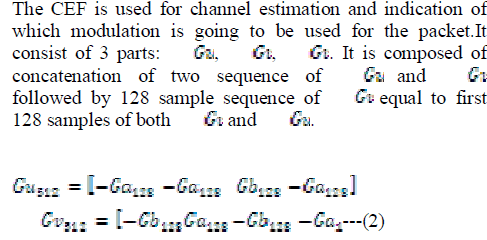 |
| The data is modulated by OFDM. CEF is 1152 chip duration.The preamble is followed by a PLCP header and PPDU. PPDU consists of many OFDM symbols and each symbol is 640 chip duration. The length of cyclic prefix is 128 chip duration, which exceeds maximum delay of the channel. The waveform of channel estimation is defined as : |
 |
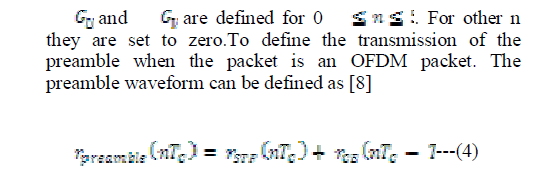 |
CHANNEL MODEL
|
| The IEEE 802.11ad standard to maintain compatibility with devices supporting it, the preamble and header of our proposed estimation are kept same as the old ones. The actual change lies in pilot tone, which are constantly changed. The transmitted signal described in complex baseband signal r(t) by the following relation. |
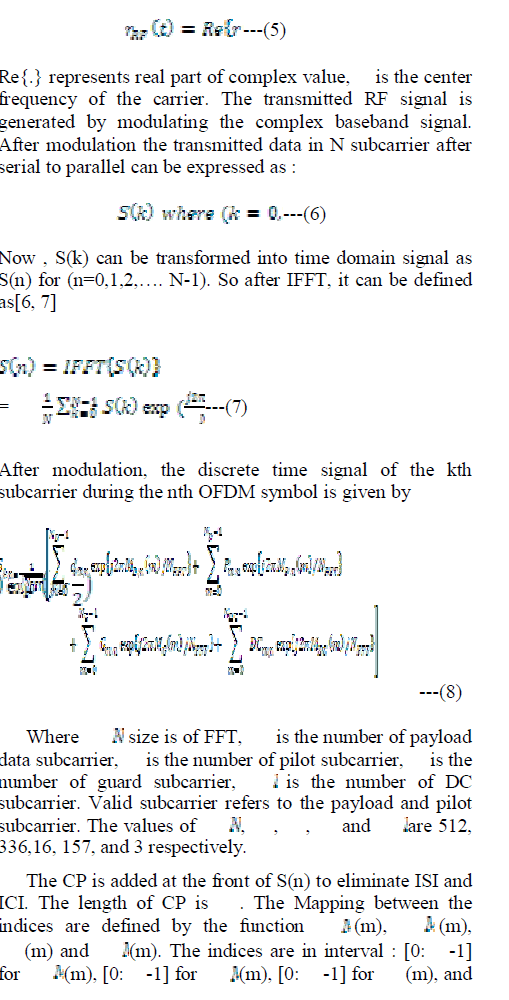 |
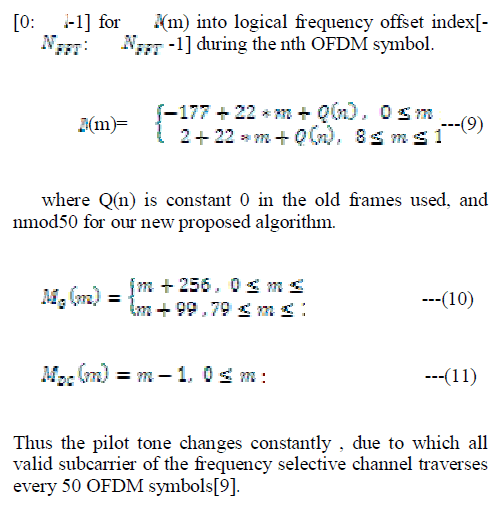 |
CHANNEL ESTIMATION ALGORITHM
|
| The channel estimation is to estimate the original transmitted OFDM symbol, where accurate channel state information(CSI) is required. The CSI can be obtained from transmitted data and pilot tones. OFDM systems utilizing coherent phase shift keying require accurate channel state information at the receiver in order to decode the transmitted signals correctly. We can obtain and track the CSI by using a channel estimator for the receiver. Channel estimation is divided into 2 groups. They are Block-type channel estimation, where pilot tones are inserted in all of the OFDM subcarrier as training signals for channel estimation. The other method uses pilot tones inserted between data subcarrier in each of the OFDM blocks and is called Comb-type channel estimation. Channel estimator usually needs some kind of pilot information as a point of reference. A fading channel requires constant tracking, so pilot information has to be transmitted more or less continuously. However an efficient way of allowing a continuously updated channel estimate is to transmit pilot symbols instead of data at certain location of the OFDM time-frequency lattice. This is viewed as pilot symbol aided modulation(PSAM) method. Synchronization is assumed to be perfect. |
| The existing channel estimation are listed and we compare our proposed method with existing Algorithms.In 60 GHz system application to reduce the computational complexity, single tap equalizer’s are used. Performance can be measured on these subcarrier. Normalized mean square error(NMSE) is generally utilized to evaluate the estimation performance given by : |
 |
| A. Algorithm 1[10] |
| Channel estimation is done only in the Channel Estimation Field(CEF) part. 2,512 successive chips of received sequence are selected at the beginning with the starting position of CEF. Due to multipath channel, the 512 chip is composed of sum of and its cyclic shift sequence namely, |
 |
| Where is the row vector of the 512 chip, is the vector comprised of the Gu512, is cyclic shift of , is the channel amplitude of the ray. is the Gaussian random noise vector. Different are approximately orthogonal. White noise sequence vector is irrevalent to , is estimated through conjugate multiplication of received sequence vector and . is corrected to be 0, if its estimated value is below certain threshold to reduce estimation error . |
| B. Algorithm 2 [11] |
| Channel estimation is done in every OFDM symbol and it is assumed to be fast variant channel. Thus the relationship |
 |
| Where is the transmitted signal. is the received signal. is white Gaussian noise and is the channel frequency response . Where k denotes kth subcarrier, n denotes mth OFDM symbol. The channel frequency response of pilot tones namely can be estimated with least square(LS) method to reduce computational complexity for 60 GHz. |
| Frequency response of pilot tones is then used to calculate the frequency response of payload tone with interpolation method. |
| C. Algorithm 3 [9] |
| Channel is assumed to be slow time-varying and Channel State Information (CSI) is approximately invariable in 22 OFDM symbol. The pilot and payload data subcarrier are fixed at 16 and 336 respectively, only the pilot tone changes constantly with the order of the OFDM symbol in a frame. Where Q(n)= n mod 22 . The channel is considered under a strict LOS condition inside a conference room. |
| D. Proposed Algorithm . |
| The new Algorithm is based on the channel , which is experiencing Frequency Selective Fading and Multipath Rayleigh environment. So, in our proposed algorithm NLOS condition is taken in consideration. Thus the channel is assumed to be slow time-varying and Channel State Information(CSI) is approximately invariable in 50 OFDM symbol. Thus in the new proposed algorithm the number of pilot and data subcarrier are fixed at 16 and 336 respectively. But the pilot tone changes every 50 OFDM symbol duration. Where Q(n)= n mod 50. All valid subcarrier tones are traversed by pilots with every 50 OFDM symbol duration. Due to constantly changing of pilot tones, the frequency response are also renewed with every 50 OFDM symbol duration for all valid subcarrier tones. These algorithm still works when channel changes relatively fast. Thus it is observed that as the signal-tonoise( SNR) ratio increases in the channel, BER relatively decreases. Thus we get decreasing error rate as the SNR rises. Thus the channel confirms that the efficiency of output is perfect. Thus the channel works perfect at high SNR. |
SIMULATION RESULTS
|
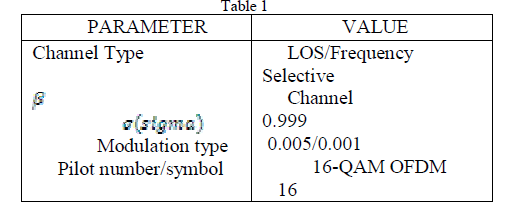 |
| Table 1 gives the main simulation parameters and the corresponding values for our proposed scenario. Many other important parameters are already mentioned in system description. We consider LOS/NLOS frequency selective fading of a conference room is selected for the channel model. Fig. 3, Shows that the NMSE performance of the above three algorithms in a frequency selective fading environment with same frame length and different rates of channel variations. |
| In relatively slow time-varying channel (Sigma=0.001). The NMSE performance of the existing algorithm 1 shows that it is low with low SNR , and it increases with the increase in SNR. The performance of the existing algorithm 2 also shows the result almost same as the algorithm 1 as it shows low with low SNR and increases with increasing SNR, while the performance of the existing algorithm 3 shows that in a slow time-varying channel(sigma=0.001) it works perfectly with increasing SNR and it shows the best performance at high SNR, while the performance of the algorithm 3 in fast time-varying channel (sigma=0.005) shows to work perfectly and can still effectively track the channel, its increases with increasing SNR and is best at high SNR. |
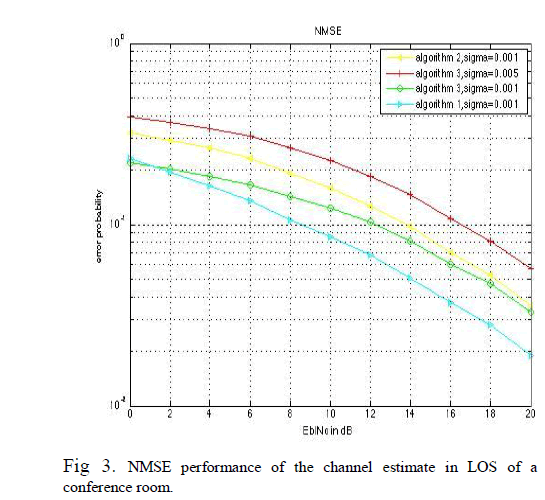 |
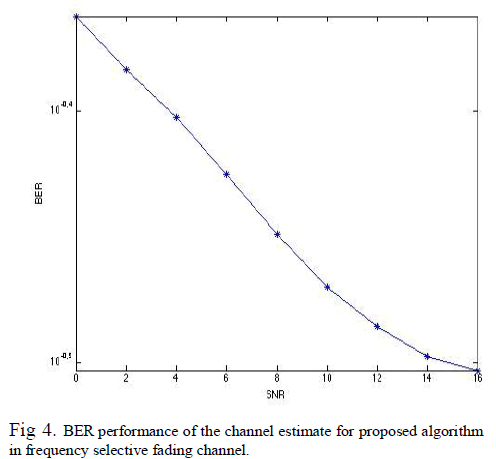 |
| Fig 4. Shows the BER performance of the proposed algorithm in a frequency selective fading environment, where the channel works perfectly and the BER decreases significantly with the increase in SNR. The proposed algorithm shows the best performance when SNR is high and it can work perfectly without errors at a range of 16 db or greater , Thus it also minimizes the noise perfectly for a 60 GHz application at high SNR . It is shown that the new channel estimation can track the channel at slow and fast time-varying channel in a frequency selective fading environment and works perfectly at high SNR and minimizing the noise developed in the channel for a 60 GHz application. |
CONCLUSION
|
| In this paper we proposed a channel estimation algorithm for a 60 GHz application and pilot design on IEEE 802.11ad standard.We can see that a frequency selective fading channel for a 60 GHz application . The pilot , data payload are fixed throughout the processing. The proposed channel estimation changes the pilot tone with every 50 OFDM symbols. Thus we observe that the error rate of the channel gets decreases as the SNR increases. Thus it is used for a fast time varying channel, where it changes within one OFDM symbol and even slow time-varying channel. Now we have proposed for a frequency selective channel model to reduce the BER. Future work in the particular field of advancement can be carried out taking the peak-to-average ratio (PAPR) in consideration. The channel should be nurtured with keeping the PAPR relation in mind to provide better performance of channel and to calculate the amplifier output |
References
|
- Amendment of Part 2 of the commission’s rules to AllocateAdditional spectrum to the Inter-satellite, Fixed,Mobile servicesand to permit unlicensed Devices to use certain Segments in the50.2-50.4 Ghz and 51.4-71.0 Ghz bands. Federal Comm, FCCET Docket No. 99-261,Dec. 2000
- H.Zhu and J.Wang, chunk-based allocation in OFDMA systems.Part 1: chunk allocation, IEEE Transaction and communication,vol.57. no.9,pp.2734-2744. Sept 2009
- H.Zhu and J.Wang, chunk-based allocation in OFDMA systems.Part 2: Joint chunk, power and bit allocation, IEEE Transactionand communication, vol.60. no.2,pp.499-509. Feb 2012
- High rate 60 GHz , PHY,MAC and HDMI PAL standardECMA-387 1st edition, 2008.
- IEEE802.15.3c-2009: Part 15.3: Wireless Medium AccessControl(MAC) and Physical layer(PHY) specification for highrate Wireless Personal Area Network(WPAN’s).
- PHY/MAC complete proposal specification IEEE P802.11adWireless LAN’s, May. 2010
- Wireless communication : JPL’s Wireless communicatonreference website. Chap: Analog and Digital Transmission.Mathematical Description of OFDM contributed byDusanMatic. 1999
- IEEE 802.11ad-2012: Part 11: Wireless Medium AccessControl(MAC) and Physical Layer(PHY) Specification for highrate Wireless Personal Area Network(WPAN’s)
- Bixing Ye and Zaichen Zhang, Improved pilot design andchannel estimation for 60 GHz OFDM based on IEEE802.11ad.IEEE Wireless and Networking Conference(WCNC): PHY.2013
- F.Hsiao, A.Tang, D.Yang, M.Pham and M.F Chang, A 7 Gb/s SCFDE/OFDM MMSE equalizer for 60 GHz Wireless Commn.IEEE Asian Solid-State circuit Conference, Vol. 12, pp no. 293- 96,Nov. 2011
- P. Hoher, S.Kaiser and P.Robertson, Pilot symbol aided channelestimation in time and frequency, Preceeding IEEE GlobalTelecommunication Conference(GLOBECOM’ 97).Comm theoryMini Conference, pp. 90-96, Nov. 1997
- B.LeFloch, R. Hallbert-Lasalle and D.Castellain, Digital AudioBroadcasting to mobile receivers, IEEE trans.Comm.Electron, VolNo.35, pp no. 493-503, Aug. 1989
- H.Sari, G.Karan and J.Janclaude, transmission technique for digitalTV broadcasting,
- IEEE Comm.Mag,Vol. 36, pp no. 100-109, Feb.1995IEEE 802.11: Wireless LAN Medium Access Control(MAC) andPhysical Layer(PHY) specification. (2007 revision). IEEE-SA. 12thjune 2007
- S Kato, ec al, Single Carrier transmission for Multi-gigabit 60 GHzWPAN systems. IEEE Journals on selected Areas in comm, Vol. 28,No.8, pp no.1466-1478, Oct. 2009
- J. Rinne and M.Renfors, Pilot spacing in OFDM systems on practicalchannels, IEEE trans.comm.Electron, Vol. 42, No.4, pp no. 959-962,Nov. 1996
- Channel Models for WLAN systems, IEEE P802.11 Wireless LAN’s2010
- PHY/MAC complete proposal specification IEEE P802.11 WirelessLAN’s , 2010
|